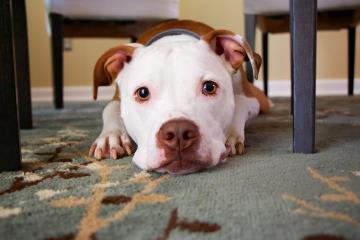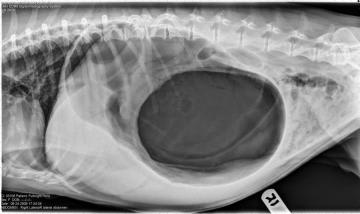
We recommend spaying or neutering your kitten or puppy. Every year, millions of unwanted dogs, cats, kittens, and puppies are euthanized. Having your dog or cat sterilized will help prevent unwanted litters, help protect against some serious health problems, and may reduce many of the behavioral problems associated with the mating instinct.
Removing a female dog or cat’s ovaries eliminates heat cycles and generally reduces the unwanted behaviors that may lead to family frustration. Early spaying of female dogs and cats can help protect them from some serious health problems later in life such as uterine infections and breast cancer.
Removing the testes from male dogs and cats reduces the breeding instinct, making them less inclined to roam and more content to stay at home. Neutering your male pet can also reduce or eliminate his risk of developing benign prostatic hyperplasia (enlarged prostate gland), prostate infections, and testicular cancer.
The procedure has no effect on a pet’s intelligence or ability to learn, play, work or hunt. Some pets tend to be better behaved following surgical removal of their ovaries or testes, making them more desirable companions.
What are the Surgical Options?
If you decide to spay or neuter your pet, you have options. Discuss the options with your veterinarian so you can make a decision that’s right for you, your family and your pet. We can give you estimates for surgical options.
Spaying your female cat or dog:
Traditional Spay (Ovariohysterectomy): The ovaries and uterus are removed from a female dog or cat. Recovery time includes restricted activity (no running, jumping or rough play) and no swimming or bathing for 10-14 days. Patients are hospitalized overnight and discharged the next day. They are monitored for pain, bleeding, and complications overnight.
Modified Laparoscopic Spay (Ovariectomy): The ovaries are removed from a female dog or cat using a harmonic scalpel. This procedure is similar to a traditional procedure but does not crush tissue, since the harmonic scalpel cuts and coagulates. This results in a less painful procedure when compared to traditional spay. It allows for a quicker recovery (7-10 days). (This procedure is reserved for cats and small dogs less than 15 pounds and less than 8 months of age). Most patients go home the same day.
Full Laparoscopic Spay (Ovariectomy): The ovaries are removed from a female dog using a laparoscope and harmonic scalpel. Laparoscopic Surgery advantages: less invasive, less painful, less anesthesia, allows for excellent visualization of abdominal organs and reduced recovery time. Recovery time includes restricted activity and no swimming or bathing for 7-10 days. Patients are usually discharged the same day as the surgery. This surgery can be performed at the time of an uncomplicated gastropexy. Recommended for patients over 15 pounds.
Is there a risk for Pyometra if the uterus is left intact?
Laparoscopic spays can include removal of the uterus, but it is not always necessary. Removal of the ovaries results in removal of the hormones that would cyclically stimulate the uterus, so the uterus remains inactive and is not prone to infection as occurs in pyometra. Studies show that there is not a statistical difference in the occurrence of pyometra in dogs that have had just the ovaries removed when compared with dogs that have had both the uterus and ovaries removed.

Neutering your male cat or dog:
Neuter (Orchiectomy): The testes are removed from a male dog or cat. Patients are typically discharged the same day. Recovery time includes restricted activity (no running, jumping or rough play) and no swimming or bathing for 7-10 days. This surgery can be performed at the time of an uncomplicated gastropexy.
Cryptorchid (Retained Testicle) Neuter: Cryptorchidism is a condition in which a testicle has not descended into the scrotum. It can be one testicle or both. Dogs with cryptorchid testicles are prone to testicular torsion and testicular cancer, so these dogs should be neutered to prevent problems later. This surgery may be performed laparoscopically. The surgeon will reexamine the location of the testicles at the surgical admittal appointment and discuss options. Recovery time includes restricted activity and no swimming or bathing for 7-10 days. Patients are typically discharged the same day as the surgery. This surgery can be performed at the time of an uncomplicated gastropexy.
Bloat and Gastropexy (Stomach Tacking to Prevent GDV in dogs):

Bloat is recognized as one of the most dramatic emergencies that we see. Bloat is when a stomach filled with gas and/or food stretches many times its normal size, causing tremendous abdominal pain. The stomach can then rotate or “flip” thus cutting off its own blood supply. Sometimes the spleen will twist too. This cuts off circulation to the heart creating a life-threatening emergency. Once the stomach flips it is called GDV (Gastric Dilatation Volvulus).
Bloat and GDV primarily affect large breed, deep-chested dogs. Both can come on suddenly. The probability is increased if the pet is active immediately after eating or drinking as the weight in the stomach aids in “flipping” the stomach. However, the stomach can flip even when your pet is simply lying down. Some large dogs are shown to have a 20% probability of developing Bloat or GDV (Gastric Dilatation Volvulus).
We offer a preventive surgery termed prophylactic Gastropexy. Simply, if the edge of the stomach is permanently attached to the wall of the abdomen, it can’t flip. Many times this surgery is performed in young pets while they are spayed or neutered, often at 6-12 months of age. This surgery can be performed laparoscopically.
What Is Laparoscopic Surgery? How Does It Benefit My Pet?
Laparoscopic (Minimally Invasive) Surgery
Both you and your pet benefit from minimally invasive surgery as there is much less pain, less anesthesia time, fewer potential complications and minimal recovery period as compared to traditional abdominal surgery. With traditional surgery, your pet is often hospitalized for several days; however, with laparoscopic surgery, you can often bring your pet home the same day.
In a traditional surgery, a large incision is made in the underside of your pet's abdomen. The surgeon opens up the incision and the abdominal cavity is exposed. After the surgeon performs the necessary procedure, your pet's abdomen is stitched together, often with several layers of sutures. Another layer of skin sutures is required in order to complete the surgery. This procedure is often quite painful if ligaments are stretched, bleeding occurs or organs are bruised.
By performing the procedure laparoscopically, there is no major incision, so your pet experiences less trauma and minimal pain. Laparoscopic procedures are performed through one or two small holes in the abdomen, typically 3/16" in size. After inserting the thin laparoscopic tube, we are able to perform surgery with magnified views of the organs, allowing for greater precision, less bruising and less bleeding. Since the tissues are carefully cut and cauterized (rather than torn or crushed), your pet experiences much less pain, fewer potential complications, minimal recovery period and a faster return to normal function than with traditional abdominal surgery.
Advantages of Laparoscopic Surgery over Traditional Surgery:
- Smaller incisions that are less painful
- Controlled cuts minimize pain and bruising
- Reduced surgical time and fewer potential complications
- Less anesthesia needed
- Allows for excellent visualization of abdominal organs
- Surgery is performed through a few tiny incisions rather than a large abdominal opening
- Reduced recovery time
Our veterinarians are highly trained in Laparoscopic Surgery and we are proud to be the first hospital in Western NC to offer this minimally invasive technique to our family of clients and pets.
